The Beijing-based news source, the Global Times, published a brief article on November 23rd describing a serious examination of an unidentifiable hair thought to be from a Hubei Bigfoot.
Click the photo on the right to access the article on the Global Times web site.
Based on the photo, the researchers at the Shennongjia Nature Reserve do not appear to be using antiquated equipment. Assumably they are government employed researchers, so it would not be a stretch to assume they could arrange to have DNA testing performed on this single hair if it was merited ... In other words, if there was some DNA in the hair.
Notice the morphology of this hair (see photo on right). It doesn't seem to have any cellular material in its core. That is unlike most animal hair, but it is a signature characteristic of North American bigfoot hair.
When there is some cellular material in the core of a hair (the "medulla"), DNA can usually be pulled from it, but if the core is empty then there is no cellular material to pull DNA from, unless there is a root ("follicle") still attached to base of the hair, or skin cells still attached, or blood. The Hubei hair does not appear to have any of those things. It appears to be an old broken piece of hair. Hence it may be obvious that there's no chance of extracting DNA from the hair, and so the examination must focus on morphology and other characteristics. Merely trying to find DNA in a hair like this would destroy it. With such rich pigmentation, this hair is more valuable to Chinese researchers if left intact.
It is rather progressive of the Chinese to perform this type of examination openly, and even publish a microscope image in the press.
America loves to tout its openness and its freedom of the press, while pointing to China as a country which limits the press and censors anything controversial ... but on this particular topic those attributes are definitely the other way around.
The American government has traditionally denied the existence of these animals, even though there are many more witnesses in America than in China. American scientists and government employees, in general, are loathe to admit interest in the subject, much less get involved.
The Chinese are more sensible about it. They realize that if there are roughly 400 recorded sightings in China over the last 100 years, then the sightings should be taken seriously. That is so sensible, and rational, and logical ... that it should make us North Americans somewhat embarassed, collectively.
Even though there are thousands of living eyewitnesses in America and Canada ... it makes no difference to our government(s) or our scientific communities.
Note the Chronology of the Dawn Redwood's Discovery
1941 Japan > 1944 China > 1948 America
Consider the state of relations between China and Japan during the early 1940's.
In 1941 Imperial Japan was trying to erase China from the map. Japanese troops were invading China. There were massacres of entire villages and mass displacement of people. It was a serious life-or-death struggle for the Chinese nation. Meanwhile, back in Japan, a well-respected scientist was in his laboratory documenting his fossil findings for all his senior scientific peers abroad, most of whom were not Japanese, but were likely old aquaintences by letters. He was documenting his discovery of a distinctive tree species. It was a giant among trees, and it once ranged across much of the northern hemisphere. It dominated the mountains of central China in particular.
Amazingly, in 1941 Chinese botanists were still receiving and reading the latest articles from their scientific peers abroad, including those in Japan.
Some time between 1941 and 1944 word got around among botanists and foresters in China about the Japanese discovery of a new, giant tree species that had defined the forest skyline of China during the Ice Age(s).
In 1944 a Chinese forester in Hubei spotted a living Dawn Redwood while scouting for strategic hideouts for people fleeing from the invading Japanese Army. Elder Chinese botanists later confirm the discovery. News of the discovery (along with packets of pinecones) traveled back to various botantical experts around the world.
In 1948, a Harvard professor organized an expedition to China to collect his own pinecones and map them to specific trees. The trees became known as "Dawn Redwood" in the West, and "Water Fir" in China.
***
What should we (Americans and Chinese) take from these facts?
If it was not treasonous in the early 1940's for scientific peers in Japan, China and America to continue communicating with each other about biological discoveries ... then it certainly should not be a problem today.
|
|
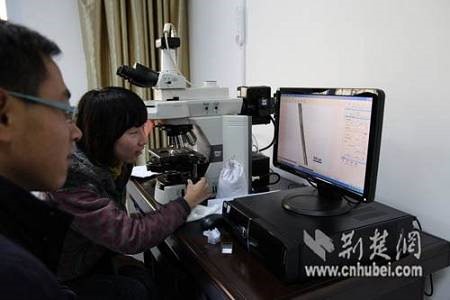
Smiling researchers at the Shennongjia Nature Reserve magnify an unidentified hair thought to be from a Hubei Bigfoot.
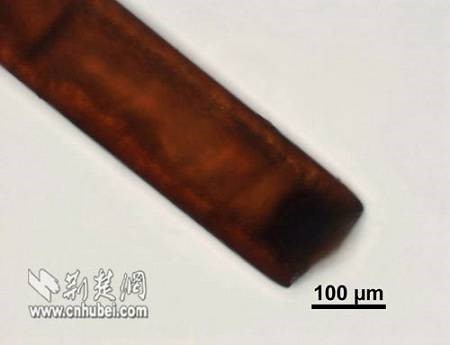
The color of the hair is interesting for a few reasons. It fits with the fur color described by witnesses in China, and it fits with the bark color of the Dawn Redwood.
For millions of years the mountains of central China were dominated by a large tree species called the Dawn Redwood. First noticed in fossils and described by a Japanese scientist in 1941, the Dawn Redwood was initially assumed to be extinct. A living specimen was found near Lichuan, Hubei in 1944. Groves of the trees were noted in the area shortly thereafter. Word got around. Pinecones were brought to the most revered senior botanist in China at the time. He sent some to Harvard Unversity. A Harvard professor then led a small expedition to Hubei in 1948 to collect pinecones, and map them to particular Dawn Redwoods.
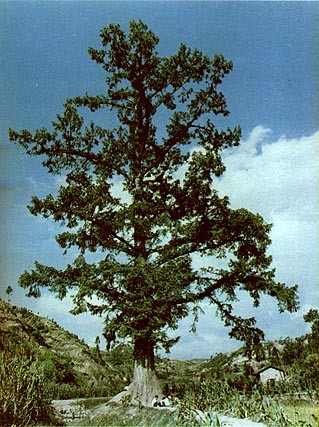
This is the first Dawn
Redwood found near Lichuan, China. This tree is over 400 years old, and is still alive today.
Its the smallest of the giants of the Sequoid family, but it has proven to be the fastest growing among them. From a population of roughly 6,000 surviving trees in central China, the Dawn Redwood is now cultivated in gardens all over the western hemisphere. Known as the "water fir" in China, it adorns the grassy perimeters of wide ceremonial boulevards in China, and some walking paths on the campus of Harvard University in the United States.
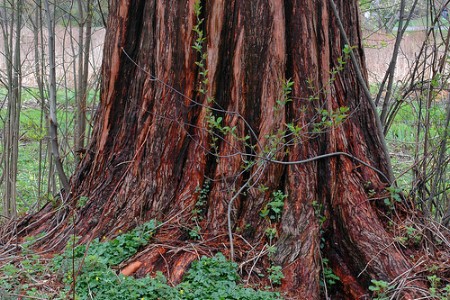
Notice the color of the bark of this Dawn Redwood on the campus of Harvard University, and then look back at the hair image above. These images have not been retouched.
If you wore no clothes, and you were covered with hair like a bigfoot, and you lived just below the seasonal snowline in this part of China throughout the Ice Age, much of your world would have been the color of the bark of this tree. If there was a survival advantage to being naturally camouflaged in that environment, the hair color of your species would eventually look very much like this color.
Any large primates living through the Ice Age in the mountains of China would have spent a lot of time around these trees.
Having a fur color matching the bark of the Dawn Redwood would have provided a distinct advantage as a predator of smaller animals. It would also make it easier to evade larger predators and hunting humans.
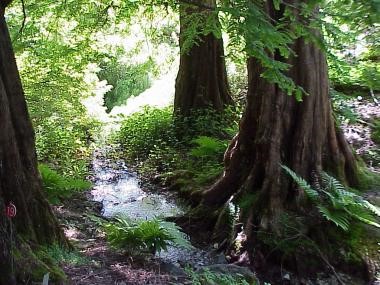
This grove of Dawn Redwoods, above, provides a glimpse of Central China's mountain forests during the Ice Age.
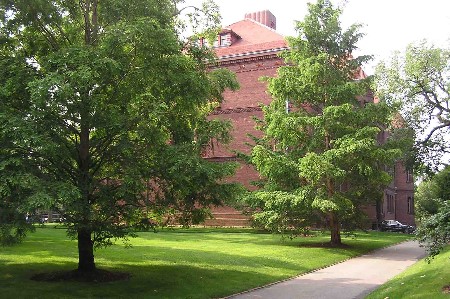
Dawn Redwoods on the campus of Harvard University, planted from pinecones collected by the Harvard-sponsored expedition to Hubei, China
in 1948.
Dawn Redwoods once covered much of the northern hemisphere. Global climate changes after the last Ice Age killed off most of them. Young redwoods are very vulnerable to desiccation. If they dry out for a few days in a row they will not recover. Even if they have ample water after the dry spell they will soon die. Adults are not as vulnerable in this way.
The Sequiod family of giant trees - Redwoods, Sequoias and Metasequoias (Dawn Redwoods), etc. --
all come from wet, misty, foggy worlds of the Ice Ages. They survived and propagated in unfailingly wet, misty places like coastal Northern California, and the southern slope of the Daba Shan Mountains in Hubei, China.
|



























